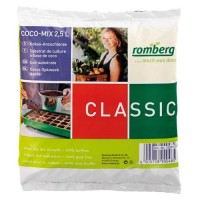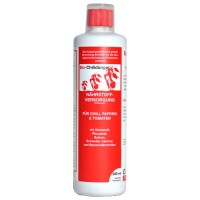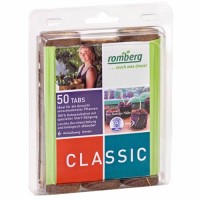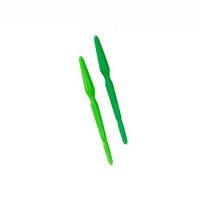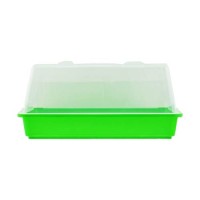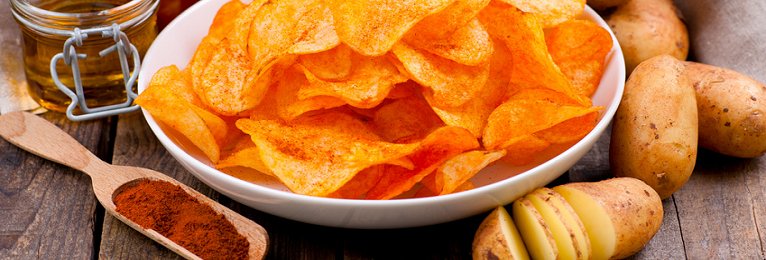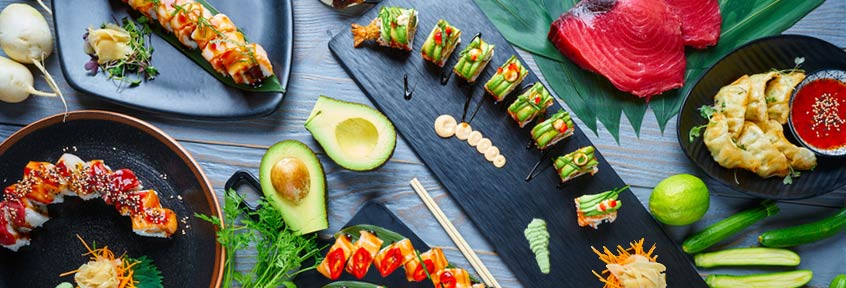Growing your own tomatoes
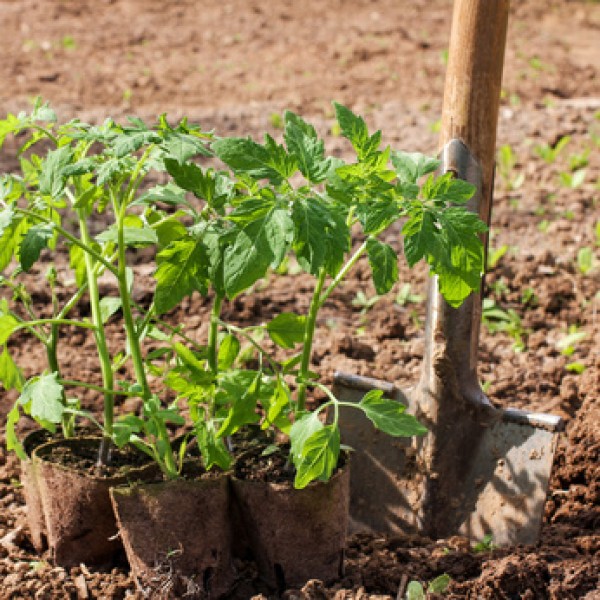
Growing your own tomatoes
How to grow your own tomatoes from seed to plant
Those who prefer to grow their own tasty tomatoes are rewarded not only with many delicious fruits in the summer, but can also be sure that they are not contaminated with pollutants, providing you do not apply pesticides and chemical fertilizers.
Before starting – what do you need?
- Quality seed (in our shop we offer more than 150 varieties)
- Sowing boxes, potting soil, cultivation trays or coir pellets
- A warm place for germinating the seeds (e.g. window sill)
- After germination a lot of light
![]() Sowing
Sowing
 Time: There are many different opinions about the best time to sow tomato seeds. It is important to know that tomatoes - unlike chillies - germinate and grow relatively quickly. So they should not grow too big until they are planted outdoors in mid-May after the final date of frost, if there is no greenhouse or the like. The best period for beginning is about mid March.
Time: There are many different opinions about the best time to sow tomato seeds. It is important to know that tomatoes - unlike chillies - germinate and grow relatively quickly. So they should not grow too big until they are planted outdoors in mid-May after the final date of frost, if there is no greenhouse or the like. The best period for beginning is about mid March.
Substrate: Quality seed and a good potting soil are already half the rent. The potting soil should be nutrient-poor, fibrous, sterile and well-drained. You can use sowing boxes, in which you fill approx. 3 - 4 cm of the potting soil. It is important that the boxes are well drained, because the seeds should be moist, but not wet.
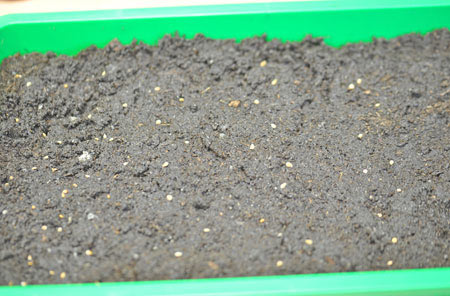 First steps: Premoisten your soil, but just moist, you dont want it soggy. Form a flat surface and then gently sow your seed on the soil. Keep a distance of about 4 to 5 cm. Then sprinkle more soil on top (approx. 1 cm), enough to cover the seeds, and moisten again. Mark your seedling flats with plant labels and waterproof pen, noting the variety of tomato. If you use seed trays or small pots for each seed, this facilitates identification.
First steps: Premoisten your soil, but just moist, you dont want it soggy. Form a flat surface and then gently sow your seed on the soil. Keep a distance of about 4 to 5 cm. Then sprinkle more soil on top (approx. 1 cm), enough to cover the seeds, and moisten again. Mark your seedling flats with plant labels and waterproof pen, noting the variety of tomato. If you use seed trays or small pots for each seed, this facilitates identification.
Germination temperature: For germination, the tomato seeds need temperatures around 24 degrees, so place the sowing box or pots in a warm place. Make sure, that the soil dont get dry.
![]() Seedlings
Seedlings
As soon as the seeds sprout and have broken through the soil surface, you can move them to a cooler (18 to 20°C) and bright place, e.g. the window sill. Remember to try to avoid large temperature fluctuations. The place should be very sunny, otherwise the seedlings tend to get fragile and too long stems. Check the soil moisture daily by putting your fingertip in the soil. If its not moist, water them carefully.
![]() Pricking out
Pricking out
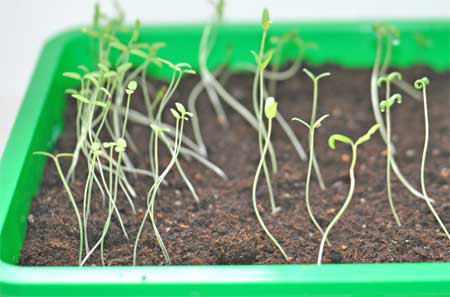 When the first pair of leaves appears after approx. 14 days, the seedlings should be transplanted into individual pots or trays (8 to 10 cm in diameter). This can be a delicate business and it is important not to damage the fine roots. It can be helpful to moisten the seedlings a few hours before transplanting. The golden rule is never to handle the plants by their stems, which bruise easily, but always by their seed leaves. You can also use a piece of wood, such as an ice lolly stick, or a dibber to separate and ease out the seedlings. It is good planning to prepare the planting holes in the trays of well-moistened compost before you actually lift out the seedlings from the sowing container. Simply ease each seedling into position with the roots falling neatly into the hole, then gently firm the compost into contact with the baby plant while still holding it by the seed leaf. Moisten with water without keeping them soggy.
When the first pair of leaves appears after approx. 14 days, the seedlings should be transplanted into individual pots or trays (8 to 10 cm in diameter). This can be a delicate business and it is important not to damage the fine roots. It can be helpful to moisten the seedlings a few hours before transplanting. The golden rule is never to handle the plants by their stems, which bruise easily, but always by their seed leaves. You can also use a piece of wood, such as an ice lolly stick, or a dibber to separate and ease out the seedlings. It is good planning to prepare the planting holes in the trays of well-moistened compost before you actually lift out the seedlings from the sowing container. Simply ease each seedling into position with the roots falling neatly into the hole, then gently firm the compost into contact with the baby plant while still holding it by the seed leaf. Moisten with water without keeping them soggy.
To harden off your seedlings you can put them outside for 2-3 hours a day, if the temperatures are above 15°C. By the second week you can leave them out all day, so they get strong stems and foliage.
![]()
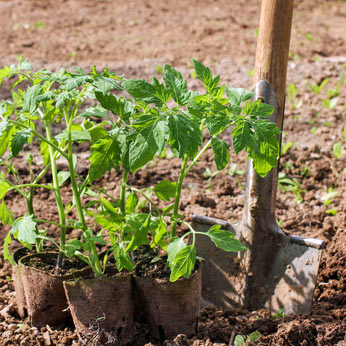 Planting out
Planting out
Usually tomato plants are planted out after the final date of night frost. Make sure they are well watered before you plant. To help give your tomatoes the best-suited environment you can, till in a good amount of compost or organic matter.
Set them out about 20 to 30 inches apart (50 – 70 cm). Plants which have reached a size of 10 cm can already be supported by stakes, in order to prevent bending. Bush tomatoes do not need staking.
Tomato Caring Tips:
- Tomatoes like a warm and sunny place.
- It is best to protect them against wind and rain. Too much rain and wetness favours diseases.
- When watering, always keep the water towards the base of the plant, and try and keep the leaves dry.
- Some gardeners prune tomatoes by pinching out suckers or the leafy shoots that grow from leaf axils. So the overall plant doesnt get top-heavy, or produce more fruit than the plant can mature in time for fall.
- Tomatoes taste better when they have more space to grow. 2.5 plants per square meter are optimal.
- If you remove the leaves under the lowest fruits, the air can circulate better and the brown rot has less attack surface
![]() Harvesting
Harvesting
Fruits are ripe when they have a solid color (red, yellow, etc.) from top to bottom, but still firm. You may need to harvest daily or every other day. In the stalk there is a breaking point where they can be picked easily when mature. If in fall there are still several green or partially ripe tomatoes on your vines, pick them and put them in a warm, dark spot and cover them with a single sheet of newspaper. Light at this point is not necessary any longer. Never store tomatoes in the refrigerator, because cold degrades their flavour. Ideal is a shady place with medium temperature.
We wish you a lot of fun with growing and enjoying your own tomatoes!
Manufacturer
Name: | Chili-Food-Wissen |
Address: |
Sehr gut
Anzucht
Ich habe die Tomaten und auch Chili selbst schon gezogen.Die Tips sind richtig, auch gut, dass auf die Temperaturen eingegangen wurde( das wissen die wenigsten und wundern sich über ihre Mißernte)
